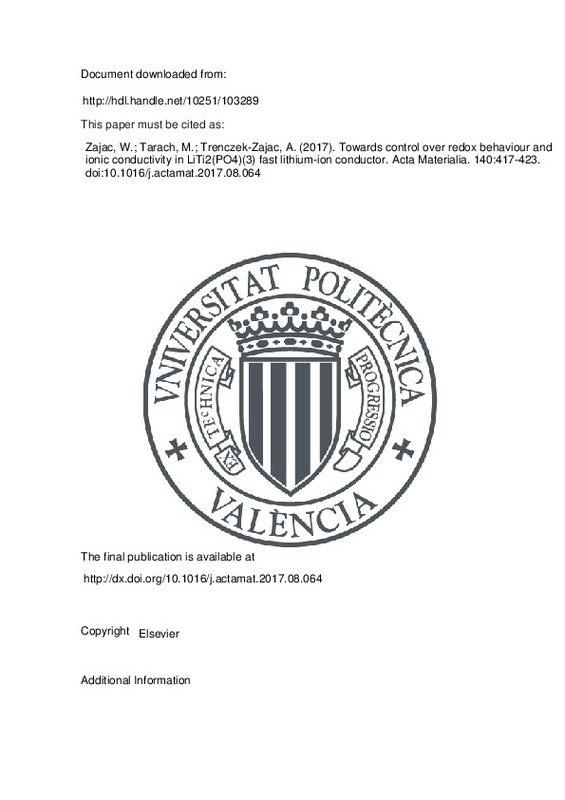JavaScript is disabled for your browser. Some features of this site may not work without it.
Buscar en RiuNet
Listar
Mi cuenta
Estadísticas
Ayuda RiuNet
Admin. UPV
Towards control over redox behaviour and ionic conductivity in LiTi2(PO4)(3) fast lithium-ion conductor
Mostrar el registro sencillo del ítem
Ficheros en el ítem
| dc.contributor.author | Zajac, Wojciech
|
es_ES |
| dc.contributor.author | Tarach, Mateusz
|
es_ES |
| dc.contributor.author | Trenczek-Zajac, Anita
|
es_ES |
| dc.date.accessioned | 2018-06-04T04:20:51Z | |
| dc.date.available | 2018-06-04T04:20:51Z | |
| dc.date.issued | 2017 | es_ES |
| dc.identifier.issn | 1359-6454 | es_ES |
| dc.identifier.uri | http://hdl.handle.net/10251/103289 | |
| dc.description.abstract | [EN] The location of redox couples in transition metal compounds is among the key factors that determine their applicability. AM2(PO4)3 NASICONs (A ¿ Na, Li; M ¿ Ti, Zr, Hf, Ge, Sn, Fe, ¿) form an intriguing group that feature fast ion diffusion and tunable reduction/oxidation potentials and can therefore find numerous applications. The present study focuses on the LiTi2(PO4)3 member of this family and the possibility of controlling its transport and redox properties. It highlights the close relationship between the modification of the crystal and band structures via substitutions in the Ti sublattice or intercalation with lithium and its redox behaviour as well as transport properties. The correlation between ionic conductivity and the position of the Ti4þ/Ti3þ redox potential is discussed. UV-VIS reflectance spectra revealed a significant impact of the type of dopant as well as the level of intercalation on the position of the fundamental absorption edge, indicating the possibility of modifying the electronic structure. In the case of some of the examined dopants (Nb, Sn, In), more complex interaction was observed, since they introduce their own redox activity, and thus enable the material's behaviour to be modified even further. | es_ES |
| dc.description.sponsorship | This work was funded by the National Science Centre of Poland as part of the grant no. 2012/05/D/ST5/00472. | es_ES |
| dc.language | Inglés | es_ES |
| dc.publisher | Elsevier | es_ES |
| dc.relation.ispartof | Acta Materialia | es_ES |
| dc.rights | Reserva de todos los derechos | es_ES |
| dc.subject | Electroceramics | es_ES |
| dc.subject | Superionic conductor | es_ES |
| dc.subject | Electrode potential | es_ES |
| dc.subject | Optical spectroscopy | es_ES |
| dc.subject | Li-ion battery | es_ES |
| dc.title | Towards control over redox behaviour and ionic conductivity in LiTi2(PO4)(3) fast lithium-ion conductor | es_ES |
| dc.type | Artículo | es_ES |
| dc.identifier.doi | 10.1016/j.actamat.2017.08.064 | es_ES |
| dc.relation.projectID | info:eu-repo/grantAgreement/NCN//2012%2F05%2FD%2FST5%2F00472/ | |
| dc.rights.accessRights | Abierto | es_ES |
| dc.description.bibliographicCitation | Zajac, W.; Tarach, M.; Trenczek-Zajac, A. (2017). Towards control over redox behaviour and ionic conductivity in LiTi2(PO4)(3) fast lithium-ion conductor. Acta Materialia. 140:417-423. https://doi.org/10.1016/j.actamat.2017.08.064 | es_ES |
| dc.description.accrualMethod | S | es_ES |
| dc.relation.publisherversion | http://dx.doi.org/10.1016/j.actamat.2017.08.064 | es_ES |
| dc.description.upvformatpinicio | 417 | es_ES |
| dc.description.upvformatpfin | 423 | es_ES |
| dc.type.version | info:eu-repo/semantics/publishedVersion | es_ES |
| dc.description.volume | 140 | es_ES |
| dc.relation.pasarela | S\353846 | es_ES |
| dc.contributor.funder | National Science Centre, Polonia |







![[Cerrado]](/themes/UPV/images/candado.png)

